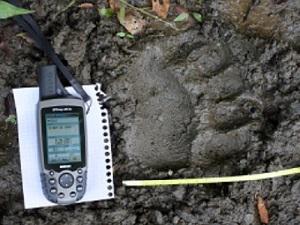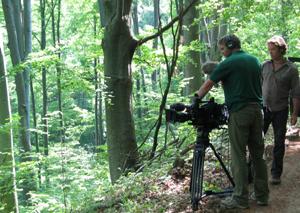Radu Mot
The project aims to identify human-dimension issues that are omitted by large-scale GIS surveys and to propose new approaches for a viable, long-term conservation initiative concerning the connectivity of large carnivore populations in the Romanian range of Carpathians Mountains.

Bear track – a large animal foraging during the autumn season. The first GPS locations documenting bear presence in Zarand Mountains, Romania; September, 2010
Under Natura 2000, 381 sites were designated for protection in Romania; however, the concept of habitat connectivity was not taken into consideration. As a result, a number of important dispersal routes for animals as well as a number of sites of high biodiversity are currently not protected. One of the most sensitive connectivity issues, not only in Romania but across the entire European Carpathian range, is the increasing habitat fragmentation between Southern and Central Romanian Carpathians, where a threatened bear population is at risk of becoming isolated. A number of large carnivore studies have sought to identify potential green corridors based on habitat requirements; however, none of these studies examined human dimensions in the context of connectivity. Recent developments in rural areas (land sales, industrial developments, illegal logging and poaching) are putting increasing pressure on the traditional co-existence between humans and animals.

The project will be conducted in the centre of a last stripe of large carnivore optimum habitat in Zarand Mountains, and will focus on the interaction between large carnivores and an impoverished small rural community from 6 villages of Petris commune, among which the practice of cohabitation with large carnivores is (mostly) forgotten. During the project, the movement and foraging patterns of large carnivores, essential for understanding their relationship with human activities, will be determined; a detailed examination of the conditions that could trigger human-wildlife conflicts and their impacts on the dispersal of carnivores will be used to produce feasible management recommendations aiming to secure population connectivity. The need for a tailored study, which includes a human dimension component, is critical due to recent political and socio-economic developments and increasing habitat fragmentation, both of which are threatening population connectivity.
One of the project’s aims is to raise awareness about carnivores as, in connectivity zones where people are unfamiliar with the habits of wolves, lynx or bears, there is a greater chance of conflicts. Using a local team is important when working with the 6 villages of Petris commune’s 1,500 inhabitants. This approach will assure a greater community involvement and long lasting impact through a capacity building approach. Recommendations, based on the data and experience gathered during the project, will be presented to a number of conservation organisations, including research institutions, NGO’s and authorities. Ongoing consultative support will be made available to those who wish to undertake a human dimensions wildlife project or develop a habitat connectivity project.